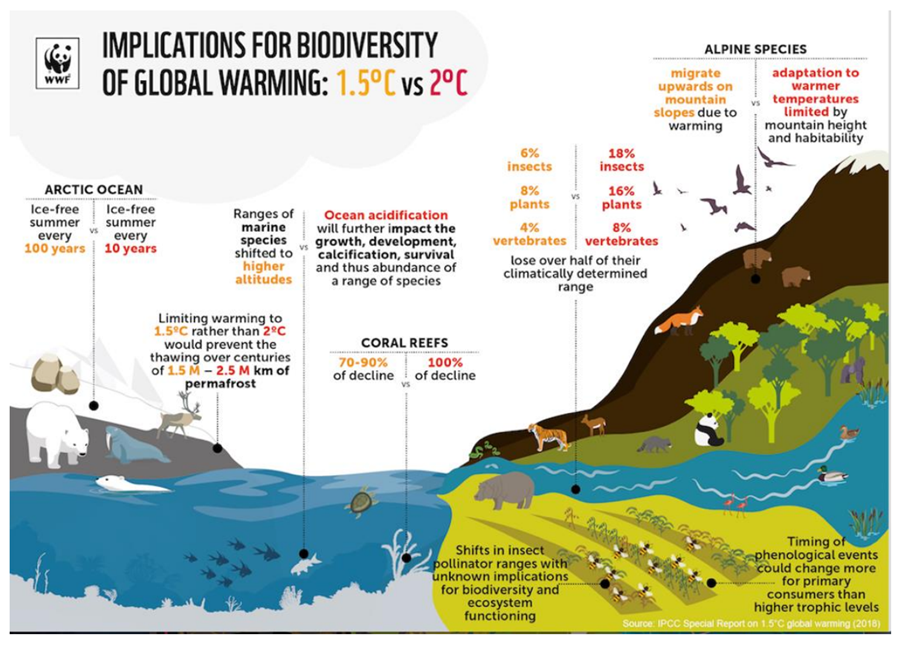Earlier in this module we looked at climate change, and the risks that uncontrolled climate change could have on our planet and our way of life.
Biodiversity is increasingly seen as an important investment theme in the movement towards achieving a carbon neutral future. In this section, we will take a closer look at the inter-relationship between biodiversity and climate change and why biodiversity plays an essential role in the future health of our planet, and the economic systems that depend on it.
The inter-relationship of biodiversity and climate change
Climate change impacts biodiversity.
The following graphics from the WWF simply illustrate how 2 degree ad 1.5 degree warming scenarios would impact global biodiversity.

Source: IPCC Special report on 1.5 degree C global warming (2018) via WWF
Biodiversity also impacts climate change.
The relationship between biodiversity and climate change is a circular one – climate change negatively impacts biodiversity and declining biodiversity exacerbates climate change. The upside of this relationship is that biodiversity presents opportunities to combat climate change.
 Read: Trophic rewilding can expand natural climate solutions pgs 1 -7
Read: Trophic rewilding can expand natural climate solutions pgs 1 -7
Key points:
- In order to meet Paris goals, we need a ‘negative emissions’ solution that removes 500 Gt of atmospheric CO2 by 2100, alongside the transition to a carbon neutral economy and halting further deforestation and land conversion
- Natural biogeochemical processes within terrestrial and marine ecosystems already remove up to 50% of all human-caused CO2 emissions annually
- ‘Animating the carbon cycle’ refers to using wild animal conservation to enhance carbon capture and storage
- Animating the carbon cycle requires dynamic landscapes and seascapes – it requires protecting and restoring the ability of animal species to reach ecologically meaningful densities so that as they move and interact with each other they can fulfil the functional roles across landscapes and seascapes that they did prior to the human interventions which led to reduced populations.
- Trophic rewilding refers to restoring and protecting animal functional roles in ecosystems
- ‘Functional roles’ mean the roles that different species play in an ecosystem, enabled and represented by their characteristics and traits
- Example: When rinderpest disease from domestic cattle decimated the Serengeti’s wildebeest population around 1900, the lack of grazing allowed enormous amounts of grass to create fuel for massive fires, releasing large quantities of carbon previously stored in the soil into the air. The Serengeti turned from a carbon sink into a source. Similar patterns have occurred in other landscapes which have experienced extinction or near-extinction of large herbivores.
- In this instance, disease control restored wildebeest populations, allowing the soil to once again absorb carbon.
- There are many other examples where trophic rewilding has the potential to significantly enhance CO2 storage – from forest elephants in Central and East Africa, to bison in North America and whales in the Southern Oceans, to muskox, reindeer, bison and wild horses in the Arctic.
- Challenges to this approach/ theory include:
- Population density and other ecosystem characteristics will have consequences on the potential impact of a given species
- Trophic rewilding of large herbivores will increase the release of methane – this ‘methane budget’ would need to be balanced against emissions from domestic livestock
Financing biodiversity – the investment opportunities
Biodiversity is about so much more than protecting specific endangered animals or improving the diversity of plant life in rural areas.
Earlier in this module we talked about the role of biodiversity as a source of natural capital and its contribution to ecosystem services that have, and will continue to, play an important role in human economic success. Protecting biodiversity is not just a moral obligation but an economic imperative.
A report from the WEF, on the Future of Nature and Business, estimates that a nature-positive economy could unlock USD 10 trillion of business opportunities by transforming the three economic systems that are responsible for almost 80% of nature loss: food, infrastructure and energy.1
Investment opportunities in biodiversity
For investors, there are a number of routes to invest in biodiversity as a theme.
Equity and Impact investing
The opportunities available to investors could be considered the flipside of the challenges to biodiversity, especially in those sectors most dependent on nature: agriculture, food and beverage, construction and pharmaceuticals.
Investors can take different approaches to integrating biodiversity considerations –
Finding solutions – strategies may look at companies actively protecting or restoring nature through their products and services. Impact investments, investments that seek to create positive, measurable social and environmental impact alongside a financial return, often seek to address specific challenges and therefore can be grouped in this category.
Engagement – active managers may work with their investee companies to improve practices to restore and protect biodiversity, through setting goals and targets or lobbying management to improve supply chain management.
Mitigation and avoidance – avoiding investing in companies whose profits or revenue are more susceptible to negative impacts from biodiversity loss, for example due to transition or physical risks of adapting business, or litigation or regulatory risks.2
Green bonds
Green bonds are bonds issued by governments, banks, municipalities, corporations and other actors to finance projects with environmental benefits.
Bonds designed to finance sustainable marine and fisheries projects (a type of “blue bond”) can also be included in this categorisation.
The Climate Bonds Initiative is a labelling scheme for entities, assets, bonds, loans & other sustainability-linked debt instruments that uses rigorous science-based criteria to ensure products are consistent with the goals of the Paris Climate Agreement.
1 New nature economy report II: The future of nature and business (no date) World Economic Forum. Available at: https://www.weforum.org/reports/new-nature-economy-report-ii-the-future-of-nature-and-business
2 Investing in biodiversity. what do you need to know? (no date) The Big Exchange. Available at: https://www.bigexchange.com/post/investing-in-biodiversity-what-do-you-need-to-know
